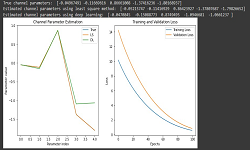5G-NR (New Radio) Modem Chipset Vendors
5G New Radio development is going at fast pace and its network rollout sounds good in very near future. These networks will not be useful without devices and devices will not work without 5G modems. So it’s makes quit interesting to know who all vendors are in the race to deliver 5G modems. Some vendors with their offering is listed below, these all are the telecom giants.
1. Qualcomm’s Snapdragon X50 5G Modem
- It’s qualcomm’s first 5G Modem and designed to support upto 5Gbps downlink data rate.
- X50 5G modem designed to support multi-element antenna arrays to work together intelligently, using beamforming and beam tracking technologies, extending mmWave’s mobility and reach to non-line-of-sight scenarios.
- It is capable of providing multi-mode 4G/5G capability via dual connectivity
- As the modem moves out of range of the 5G wireless network, it is designed to switch to Gigabit LTE automatically and provide seamless connectivity.
- This modem can be used for Fixed wireless broadband as well as for mobile broadband. In fixed wireless applications, X50 can replace fiber-to-the-home (FTTH) installations with wireless 5G connections.
- With QTM052 it can support for up to 800 MHz of bandwidth in the 26.5-29.5 GHz, 27.5-28.35 GHz, and 37-40 GHz mmWave spectrum bands.
- It also capable of supporting beam forming, beam steering, and beam tracking for bi-directional mobile mmWave communication using QTM052 antenna module
Read More at following links:
- https://www.qualcomm.com/products/snapdragon/modems/5g/x50
- https://www.qualcomm.com/products/qtm052-mmwave-antenna-modules
2. Samsung’s Exynos Modem 5100:
Exynos Modem 5100 is making 5G is a reality . EXYNOS 5100 is fully compliant with 5G NR (New Radio) standard to support new spectrums including sub-6GHz and mmWave for faster data speed of up to 6Gbps. Furthermore, the Exynos 5100 is the industry’s first multi-mode modem that supports 5G NR with the legacy modes from 2G to 4G LTE. The modem is built on 10LPP process for low power, and is delivered as a single chipset that consists of modem, RF IC, ET (Envelop Tracking) and power management IC for faster time-to-market. With the Exynos 5100, 5G NR enables various brand new experiences through enhanced broadband (eMBB) and massive connection with ultra-reliable and low latency (URLLC).
The Exynos Modem 5100, built on the advanced 10nm FinFET process with low-power design, features better power efficiency. The Exynos Modem 5100 is delivered with the Envelope Tracking IC that efficiently determines the power supply voltage needed by tracking and optimizing signal level in real-time.
- Technology support : 5G NR Sub-6GHz, mmWave, FD-LTE, TD-LTE, HSPA, WCDMA, CDMA, EDGE/GSM
- Downlink Features: 8CA (Carrier Aggregation) in 5G NR, 8CA (Carrier Aggregation) in LTE, 4×4 MIMO, FD-MIMO, Modulation up to 256-QAM in sub-6GHz, Modulation to 64-QAM in mmWave
- Uplink Features:2CA (Carrier Aggregation) in 5G NR, 2CA (Carrier Aggregation) in LTE, Modulation up to 256-QAM in sub-6GHz, Modulation up to 64-QAM in mmWave
Read More details at :
3. MediaTek’s Helio M70
Helio M70 chip supports 5G NR (New Radio), and meets the latest 3GPP Release 15, 5G new radio (NR) standard interface and includes support for standalone (SA) and non-standalone (NSA) network architectures.It is capable of supporting both sub-6GHz and mmWave frequency bands defined by the 5G standard and will meet operator and regional requirements.
This modem will be build by TSMC’s 7nm manufacturing process, incorporating EUV technology to support data rate upto 5Gbps in downlink. It will also support critical carrier features
Read more :
4. Intel’s XMM 8xxx Modem:
XMM 8000 series is Intel’s first family of 5G New Radio (NR) multi mode modem. Intel has introduced two chipset series to support 5G namely XMM 8000 and XMM 8060 on its road map.
- XMM 8000 Series: This series modems will be commercial 5G multi-mode modems, operating in both sub-6 GHz and millimeter wave global spectrum bands. The series will enable a range of devices to connect to 5G networks – from PCs and phones to fixed wireless consumer premise equipment (CPE) and even vehicles.
- XMM 8060: This series modems will be commercial 5G modem, capable of delivering multi-mode support for the full 5G non-standalone and standalone NR, as well as various 2G, 3G (including CDMA) and 4G legacy modes.
Read more :
- https://newsroom.intel.com/news/intel-introduces-portfolio-new-commercial-5g-new-radio-modem-family/
5. Huawei Balong 5G01
Huawei has launched 5G “Customer Premises Equipment (CPE) ” supporting the globally recognized 3GPP telecommunication standard for 5G. It is based on its in-house developed Balong 5G01 chipset.
Balong 5G01 is capable of providing theoretical downlink speeds of up to 2.3Gbps. It supports 5G across all frequency bands including sub-6GHz and millimeter wave (mmWave) to enable a single 5G solution suitable for multiple use cases.
This 5G CPE has two models
- Low frequency (sub6GHz) 5G CPE: It is small and lightweight, compatible with 4G and 5G networks, and has proven measured download speeds of up to 2Gbps – 20 times that of 100Mbps fiber. This provides an ultra-fast experience, allowing users to enjoy VR video and gaming experiences, or download a TV show within a second.
- High frequency (mmWave) 5G CPE : The high frequency solution is available in indoor and outdoor units.
Read more :
Related Post:
- 5G Network Sharing: Concept, Benefits and Architectures
- Hybrid Core Network – 4G Core to 5 G Core Interconnection
- Deployments Scenarios for 5G-NR
- 5G Key Performance Indicator Definitions Template by 3GPP
- 5G End to End KPI – Accessibility, Integrity and Utilization
- 5G NR gNB Logical Architecture and Its Functional Splits



